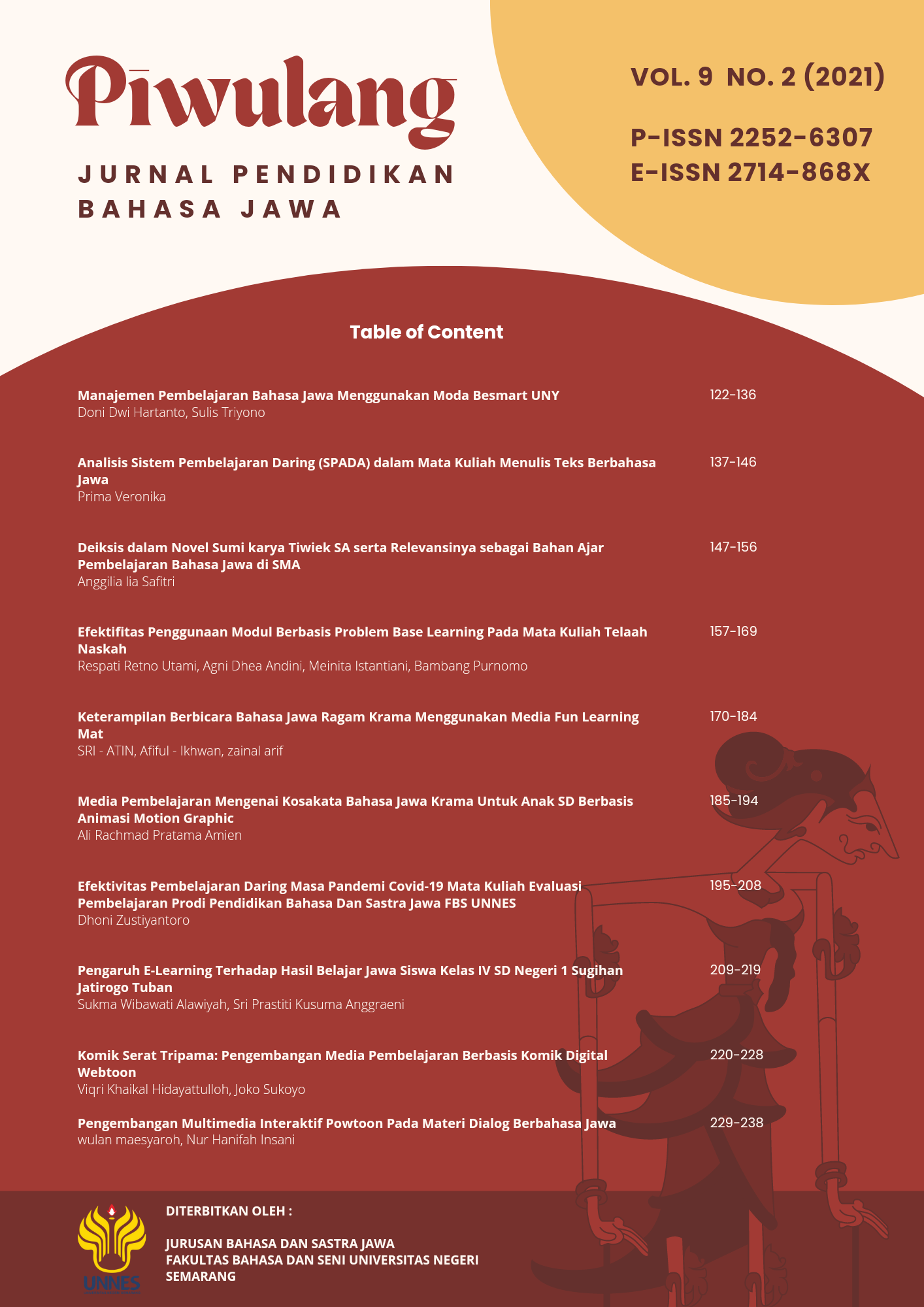Pengaruh E-Learning Terhadap Hasil Belajar Jawa Siswa Kelas IV SD Negeri 1 Sugihan Jatirogo Tuban
##plugins.themes.academic_pro.article.main##
Abstract
This study aimed to analyze the effect of e-learning on the learning outcomes of fourth grade Javanese script students at SD Negeri Sugihan Jatirogo Tuban. This study used an experimental method with the research design was the control group pretest-posttest design, namely experimental research conducted on two groups of classes. In implementing this study, students were given a pretest. Then, after being given a different treatment between the controller class and the experimental class, a posttest was carried out. The test given was in the form of multiple choice test. In addition to the test, there were also supporting data in the form of interview questionnaires for the parents of fourth grade students. The results obtained that the posttest average score of the experimental class students was (80,96), that showed it was increased significantly compared to before receiving treatment (51,68). This study concluded the effect of learning on the learning outcomes of fourth grade Javanese script students at SD Negeri 1 Sugihan Jatirogo Tuban. The learning obstacle of e-learning based at SD N 1 Sugihan, Jatirogo, Tuban was inadequate internet network facilities.
##plugins.themes.academic_pro.article.details##
References
Azizah, S., A. Suyatna, and I. Wahyudi. 2017. “Pengaruh Penggunaan E-Learning Dengan Schoology Terhadap Hasil Belajar Siswa.” Jurnal Pembelajaran Fisika Universitas Lampung 5(2): 116242.
Adam, Andi et al. 2019. “Penggunaan Media YouTube Berseri Dalam Peningkatan Kemampuan Menulis Siswa Di Sekolah Dasar.” 6.
Aarista, Sianipar. (2013). “Pemanfaatan Youtube di kalangan mahasiswa.” Jurnal Ilmu Komunikasi FLOW, 2(3), 1–10. Retrieved from https://jurnal.usu.ac.id/index.php/flow/article/view/9930/4418
Ibrahim, Doni Septumarsa, and Siti Partini Suardiman. 2014. “Pengaruh Penggunaan E-Learning Terhadap Motivasi Dan Prestasi Belajar Matematika Siswa Sd Negeri Tahunan Yogyakarta.” Jurnal Prima Edukasia 2(1): 66.
Irawan, Andi Wahy, Dwisona, and Mardi Lestari. 2020. “Psyhological Impacts of Students on Online Learingdurung He Pandemic Covid-19.” Konseli: Jurnal Bimbingan dan Konseling (E-Journal) 07(1): 53–60.
Nasution, Abdul Khaliq R. 2019. “Youtube as a Media in English Language Teaching (ELT) Context: Teaching Procedure Text.” Utamax : Journal of Ultimate Research and Trends in Education 1(1): 29–33.
Nugraha, S. A., T. Sudiatmi, and M. Suswandari. 2020. “Studi Pengaruh Daring Learning Terhadap Hasil Belajar Matematika Kelas IV.” Jurnal Inovasi Penelitian 1(3): 265–76.
Nuryadi, dkk. 2017. Dasar-Dasar Statistik Penelitian. Yogyakarta: Sibuku Media.
Pane, Dewi Nurmasari, Miftah EL Fikri, and Husni Muharram Ritonga. 2018. “Penggunaan Media Pembelajaran Video Youtube Untuk Meningkatkan Minat Dan Hasil Belajar Menggambar Ilustrasi Siswa Di Kelas VIII E SMP Negeri 1 Padang.” Journal of Chemical Information and Modeling 53(9): 1689–99.
Sevilla, G Consuelo dkk. 1993. Pengantar Metode Penelitian. Jakarta: UI-PRESS.
Sudjana Nana. 2010. Dasar-Dasar Proses Belajar. Bandung: Sinar Baru.
Supeno et al. 2019. “Utilization of WhatsApp Application as Communication Media in Language Teaching and Learning at FBS UWKS.” Journal of Physics: Conference Series 1175(1).
Tri Ani, Catharina. 2004. Psikologi Belajar. Semarang: UNNES PRESS.
